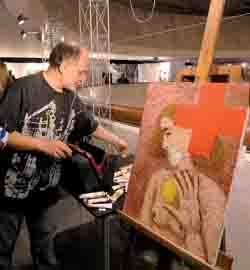Art helps fight flu
Ukrainian artists are helping orphanages and enhancing the nation’s cultural immunity
Strengthening the nation’s cultural immunity proves the best treatment against any viral infections — such is the conviction of the leading Ukrainian artists and the Ukrainian Home. Contemporary art is challenging swine flu with the aid of paintbrushes, the Manifesto of Healthy Artists, and media support. The artistic process in Ukraine (involving artists, curators, and art gallery managers, including Arsen Savadov, Oleksandr Roitburd, Olesia Avramenko, Vlada Rapko, Illia Chichkan, Pavlo Makov, Mykola Matsenko, Oleh Tistop, Yurii Solomko, Maksym Mamsikov, and others) is proudly showing its social stand.
The organizers of the Project “Contemporary Art Challenging Swine Flu” admit that they didn’t expect such an active response from the artistic community. In fact, the latter made blitz arrangements — within a single day — for what they recognized as an emergency project. They further used a blitz mode to rally their creative efforts, working hard for several hours and coming up with anti-epidemic pictures, so that on November 7 some 40 works of art were sold at an auction in the Ukrainian Home. The proceeds would be used to purchase medications, vitamins, fruit, and vegetables that would be transferred to orphanages.
There was also a manifesto, in keeping with the best conceptualistic tradition. It reads that “actual art is becoming more social-oriented… On the one hand, it may aggravate the problems and viewpoints; on the other hand, it can serve to harmonize the situation, remove strain, and lessen the burden of social tensions. Our artists are becoming realistic, while our politicians are more in the mystification field.”
Says Yevhen Karas, artist and gallery manager: “I would like to emphasize three aspects of this project. First, art is being socialized; it keeps pace with the realities and synthesizes them. Second, it ‘engraves’ social problems. Finally, it lends a helping hand to those who are really in need.”
And so, relying on Karas’ assessment, we have a trilateral stand in terms of actual Ukrainian art. Won’t art as such suffer from these ramifications?
Says Lesia Avramenko, the curator of the anti-epidemic artistic project: “We have invited leading artists to take part in this project; whatever they create will be true works of art, even though the project is socially oriented in the first place; things artistic and social constitute a very modern synthesis.”
Says the artist Oleksandra Zhumailova-Dmytrovska: “These spheres coexist productively because actual art is a huge experimental lab. We, the artists, respond to visual images in the first place. When we first learned about ways to prevent the spread of the flu, I told myself there would soon appear posters reading something like ‘Are You Wearing the Mask?’ and fashion designers would include such masks, even embroidered ones, in their podium parades. I mean the process was launched immediately, even if several weeks after the first alarming signals. This project could be described as the first response. Six months from now, this topic will be treated in greater depth, not in such a straightforward manner.” Thirsting for any nonstandard reflections of reality, the contemporary art industry appears to have digested and made good use of even this extraordinary phenomenon, swine flu, which is so remote from esthetic concepts. Surgical masks and panic moods have been made subject of irony expressed on canvas. These paintings will be sold at an action.
Some artists had no problems working in the reality show format. Others (for example, Oleksandr Roitburd) had spats with journalists, whom they regarded as perfect nincompoops who, in their opinion, didn’t know about the creative process but kept intruding with flashes and questions. Take the etcher Pavlo Makov, for example. His art requires jeweler’s precision. His works of art cannot be made quickly a priori.
“Personally, I can’t produce a painting in two hours. Not even at my studio where I can work in peace and quiet, and even less so when working in public, in front of three of four cameras. I will simply contribute my small work to the auction. Over the past couple of years the social stand has become part of promotion for the artists. In actuality, the closer art gets to the social environment, the more such works of art look profane. At a certain point the nonconformist approach became the predominant commercial part of the arts, playing the leading role during the contemporary biennial and triennial exhibits. I think that the more social functions art acquires, the less the extent to which it can implement them. Art has become part of the mass media, of a big sociopolitical show. The more openly art insists on its social functions, the more involved it becomes in this show, thus losing its ability to influence each separate individual,” says Makov.
However, if we return from artistic realities to those of a child’s life in an orphanage, this excessively socialized conduct on the part of artists appears to be justified, if not outright exemplary.






